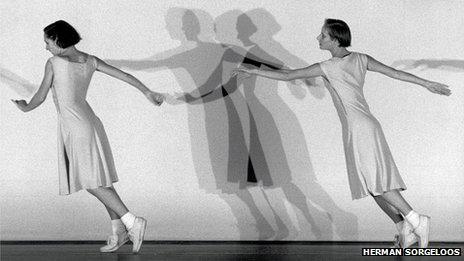Tate Modern's oil tanks to fuel live art performances
- Published

Tate Modern's underground oil tanks are to become the world's first permanent museum galleries dedicated to live art.
The giant chambers will launch with a 15-week arts festival from 18 July, as part of the London 2012 Festival .
"This is an exciting moment for the Tate," said its director Nicholas Serota.
"The Tanks will be the first spaces dedicated permanently to live art installation and performance in any museum building anywhere in the world."
Tate bosses say the work in the Tanks will reflect a greater public appetite to engage with art and artists.
The Tanks are the first phase of a £215 million extension project that will increase Tate Modern's size by 60% by adding 21,000 square metres of new space.
Serota said that 75% of funding - more than £162 million - had been had been raised and he hoped building work would be complete before December 2016.
The project has received £50 million of government money, £7 million from the Greater London Authority and the remainder from private donors who "wish to remain anonymous".
The South and East Tanks originally contained oil that fuelled the power station - now occupied by Tate Modern - and have been unused since it was decommissioned in 1981.
Each one is some 30 metres across and seven metres high.
The giant subterranean spaces will now host live art and film programmes, which have previously been presented in diverse spaces around Tate Modern.
"We will see many more works which involve the spectator," said Tate Modern director Chris Dircon. "There is an incredible appetite for participation."
The opening programme in the East Tank includes a major new commission by South Korean artist Sung Hwan Kimn "which sees him interweave Korean culture, folklore and history, his own personal experiences and fantasy".
The South Tank will host a rolling series of projects including one by Belgian choreographer Anne Teresa de Keersmaeker, who will rework and perform a version of her early work, 1982's Fase: Four Movements to the music of Steve Reich.
London-born artist Eddie Peake, whose previous work includes a choreographed a football game for nude players, will create a new commission that "explores sexuality and voyeurism".
There will also be a 10-day young people's festival called Undercurrent, and families will be invited to take part in a film-making project that will see their works projected onto the circular walls of the Tanks.
The Transformer Galleries, the raw concrete spaces next to the Tanks, will showcase installations of recent major acquisitions of film and performance. These will include Suzanne Lacy's Crystal Quilt 1987, an exploration of the visibility of older women in the media.
"Over the last 10 years we have been responding to the way art and artists have evolved in their thinking," said Serota at Monday's launch.
"The public wishes to engage with these works in a very different way from simply going into a gallery and observing a work on a wall."
The inaugural festival inside the Tanks runs from 18 July to 28 October 2012. Afterwards, the Tanks will be closed during some periods to enable building work on the new galleries above.
- Published2 April 2012
- Published8 September 2011
- Published6 January 2010